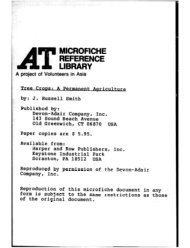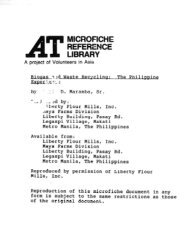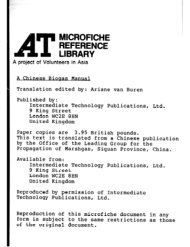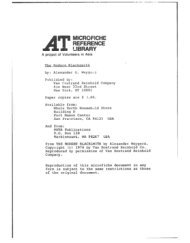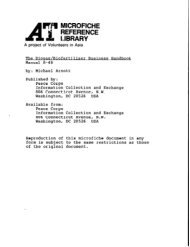Vegetation as an indicator of high wind velocity
Vegetation as an indicator of high wind velocity
Vegetation as an indicator of high wind velocity
Create successful ePaper yourself
Turn your PDF publications into a flip-book with our unique Google optimized e-Paper software.
Larson, P.R., 1965: Stemform <strong>of</strong> you Larix <strong>as</strong> influenced by <strong>wind</strong> <strong>an</strong>d<br />
pruning. For. Sci. 11: 412-424.<br />
Unidirectional <strong>an</strong>d multidirectional <strong>wind</strong>s from oscillating<br />
electric f<strong>an</strong>s were applied to a young Larix tree. The size <strong>an</strong>d vigor <strong>of</strong><br />
the live crown determined mostly the stem form. Exposure to <strong>wind</strong> caused<br />
a pronounced downward shift <strong>of</strong> increment towards the stem b<strong>as</strong>e, usually<br />
at the expense <strong>of</strong> upper stem parts. Prevention <strong>of</strong> <strong>wind</strong> sway by staying<br />
the trees largely eliminated the downward shift <strong>of</strong> increment. Height<br />
growth <strong>of</strong> free swaying trees w<strong>as</strong> also reduced, <strong>an</strong>d this reduction w<strong>as</strong><br />
partially <strong>of</strong>fset by staying. Trees responded to unilateral <strong>wind</strong>s by<br />
producing eccentric growth on the lower stem consisting <strong>of</strong> <strong>high</strong> proportion<br />
<strong>of</strong> reaction wood. However, the incre<strong>as</strong>ed increment on the lower bole<br />
<strong>of</strong> trees exposed to multilateral <strong>wind</strong> consisted <strong>of</strong> wood <strong>of</strong> normal structure<br />
uniformly distributed circumferentially.<br />
Lawrence, D.B., 1959: Some features <strong>of</strong> the vegetation <strong>of</strong> the Columbia<br />
River Gorge with special reference to <strong>as</strong>ymmetry <strong>of</strong> forest trees.<br />
Ecol. Monogr, 9, (2), 217-257.<br />
This paper presents not only <strong>an</strong> expl<strong>an</strong>ation <strong>of</strong> the effects <strong>of</strong><br />
<strong>wind</strong> in the Columbia Gorge but also presents descriptions <strong>of</strong> the geology,<br />
topography, soils, flood history <strong>an</strong>d trihutsry drainage systems. It<br />
describes the two types <strong>of</strong> tree deformation in the Gorge; the <strong>wind</strong> trained<br />
crowns in the e<strong>as</strong>tern portion <strong>of</strong> the Gorge <strong>an</strong>d the pruned crowns in the<br />
western end <strong>of</strong> the Gorge caused by strong e<strong>as</strong>t <strong>wind</strong>s <strong>an</strong>d heavy ice<br />
deposition.<br />
Mayhead, G.J., 1973b: Sway periods <strong>of</strong> forest trees. Scot. For. 27: 19-23.<br />
The sway period <strong>of</strong> confiers in a closed c<strong>an</strong>opy is found to<br />
incre<strong>as</strong>e with incre<strong>as</strong>ing tree size. The results from this study support<br />
the view that sway period c<strong>an</strong> be satisfactorily expressed in terms <strong>of</strong> the<br />
,le.-ghr, diameter at bre<strong>as</strong>t height <strong>an</strong>d m<strong>as</strong>s <strong>of</strong> the tree. The natural sway<br />
period <strong>of</strong> the tree, the gust frequency distribution <strong>of</strong> the <strong>wind</strong> at <strong>an</strong>d<br />
approaching, the <strong>wind</strong> speecls causing <strong>wind</strong>throw, <strong>an</strong>d the damping prcperties<br />
<strong>of</strong> the tree, all contribute to <strong>wind</strong>throw.<br />
Mayhead, G,J., 1973a: Some drag coefficients for British forest trees<br />
derived from <strong>wind</strong> tunnel studies. Agric. Meteor. 12: 123-130.<br />
A <strong>wind</strong> tunnel w<strong>as</strong> used to determine the drag coefficient <strong>of</strong> a<br />
variety <strong>of</strong> commerical conifers. The drag coefficients varied within <strong>an</strong>d<br />
between species, <strong>an</strong>d with <strong>wind</strong> speed. Fixed drag coefficients were<br />
estimated for use in critical tree height calculations. The practical<br />
applications <strong>of</strong> drag coefficients <strong>an</strong>d critical tree heights are discussed.<br />
Some conclusions reached include: Large variations in drag coefficient<br />
were found between tree species; relatively large variations in drag<br />
coefficient occur both within a genus <strong>an</strong>d within a species; <strong>an</strong>d a sharp<br />
reduction in drag coefficient occurs with incre<strong>as</strong>ing <strong>wind</strong> speed.<br />
- 56 -



